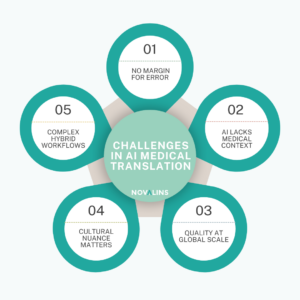From human expertise to AI and multilingual validation: The new era of medical translation
The language services landscape is evolving at an unprecedented pace. Not long ago, organizations primarily relied on human translators to ensure linguistic precision, tone, and cultural relevance. The introduction of machine translation (MT) changed that, offering impressive speed and scale—but often at the cost of nuance and quality assurance.
We’re now entering a new chapter: the integration of AI-powered translation technology and a growing emphasis on multilingual content validation. This development is particularly important in public health and regulatory communication, where accuracy is critical and multilingual rollout must often happen under strict timelines.

As artificial intelligence becomes a central component of translation workflows, companies are rethinking how they manage quality, especially for sensitive, high-impact content.
AI translation and the shift to internal workflows
Some organisations are adopting AI-powered translation workflows internally, including public bodies seeking faster multilingual delivery. This approach offers key advantages:
- Faster content delivery
- Lower translation costs
- Greater control over multilingual communications
Yet even the most advanced AI lacks the domain-specific knowledge and contextual sensitivity required for reliable healthcare translation—where even minor errors can have serious consequences.
To address this, companies are developing hybrid processes: automated translation is followed by internal post-editing, and then reviewed by external specialists in medical language. This model signals a shift in how companies engage with language service providers (LSPs): not just as translators, but as expert validators and quality consultants.
A real-life use case: rethinking the translation process
One of our recent collaborations illustrates this shift. A public health body was preparing to launch new multilingual guidelines, requiring translation of sensitive health-related content for international audiences.
Instead of outsourcing the entire process, the client leveraged AI internally to generate translations and handled the first round of editing in-house. But for validation—especially of the medical terminology and overall content integrity—they turned to us.
Our role was to verify the medical accuracy, terminology consistency, and compliance with healthcare standards. This strategic collaboration highlights how LSPs are becoming essential partners in validation and compliance, not just content delivery.
Why validation is the cornerstone of medical translation?
This isn’t just an isolated case—it represents where the industry is headed.
We anticipate more organizations will combine internal AI tools with external validation to balance speed with quality. In high-stakes fields like healthcare, multilingual content validation isn’t optional—it’s foundational.
It’s not just about translating text anymore—it’s about ensuring that content is medically sound, culturally appropriate, and contextually clear in every target language. The risks of error are simply too high in this domain.
Final thoughts: Collaboration is key to quality
While AI and internal post-editing can accelerate multilingual production, relying solely on such processes for public health content carries risk. Independent review by qualified medical linguists is vital to ensure accuracy, compliance with regulations, and protection of public trust.
That’s why certification and domain expertise are becoming critical. Certified medical translators bring the training and experience needed to work with complex, sensitive materials—ensuring every word meets the highest standards.
LSPs like Novalins aren’t just service providers—they’re strategic partners who can guide organizations in building quality-driven workflows for multilingual healthcare communication.
Looking ahead, we expect even tighter integration between AI tools and expert human validation. Automation will continue to enhance efficiency, but true quality will always require skilled professionals who understand both the science and the language.
At Novalins, we support organizations throughout this journey—from AI integration to multilingual validation. As your partner in quality, we help ensure your health content is accurate, compliant, and trustworthy—because in healthcare, nothing matters more than getting it right.
References
- Noll R, Frischen LS, Boeker M, Storf H, Schaaf J. Machine translation of standardised medical terminology using natural language processing: A scoping review. N Biotechnol. 2023 Nov 25;77:120-129. doi: 10.1016/j.nbt.2023.08.004. Epub 2023 Aug 29. PMID: 37652265.

